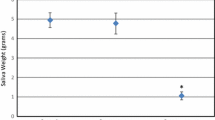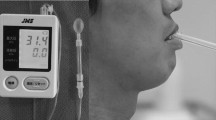Abstract
Reliable measurement tools are essential to achieve rigor in dysphagia research. In order for tongue pressure to be measured accurately in the head and neck cancer population, where change in function needs to be captured over time, a reliable tool is required. Assessing the reliability of tools that are used in swallowing evaluation has been a neglected area of dysphagia research. This article evaluates and compares the reliability of two variants of the Kay Swallowing Workstation (KSW) three-bulb silicon tongue pressure array (hand-held and fixed-position) when used to capture oral tongue pressures in two groups of participants diagnosed with head and neck cancer who had not yet commenced cancer treatment. Tongue pressure data and videofluoroscopic images were collected and recorded simultaneously onto the KSW while participants swallowed set quantities of liquid and pudding boluses. Peak amplitude tongue pressures were extracted and used in analyses. Systematic and nonsystematic variability were examined using analysis of variance and intraclass correlation coefficients, respectively. The fixed-position array demonstrated better reliability than did the hand-held method. This should be further investigated with a larger participant sample.




Similar content being viewed by others
References
Baker BM, Fraser AM, Baker CD: Long-term postoperative dysphagia in oral/pharyngeal surgery patients: subjects perceptions vs. videofluoroscopic observations. Dysphagia 6:11–16, 1991
Colangelo LA, Logemann JA, Pauloski BR, Pelzer HJ, Rademaker AW: T-stage and functional outcome in oral and oropharyngeal cancer patients. Head Neck 18:259–268, 1996
Hamlet S, Jones L, Mathog R, Bolton M, Patterson R: Bolus propulsive activity of the tongue in dysphagic cancer patients. Dysphagia 3:18–23, 1988
Kendall KA, McKenzie SW, Leonard RJ, Jones C: Structural mobility in deglutition after single modality treatment of head and neck carcinomas with radiotherapy. Head Neck 20:720–725, 1998
Lazarus CL, Logemann JA, Pauloski BR, Colangelo LA, Kahrilas PJ, Mittal BB, et al.: Swallowing disorders in head and neck cancer patients treated with radiotherapy and adjuvant chemotherapy. Laryngoscope 106:1157–1166, 1996
Lazarus CL, Logemann JA, Pauloski BR, Rademaker AW, Larson CR, Mittal BB, et al.: Swallowing and tongue function following treatment for oral and oropharyngeal cancer. J Speech Lang Hear Res 43:1011–1023, 2000
Pauloski BR, Logemann JA, Fox JC, Colagelo LA: Biomechanical analysis of the pharyngeal swallow in postsurgical patients with anterior tongue and floor of mouth resection and distal flap reconstruction. J Speech Lang Hear Res 38:110–123, 1995
Pauloski BR, Rademaker AW, Logemann JA, Stein D, Beery Q, Newman L, et al.: Pretreatment swallowing function in patients with head and neck cancer. Head Neck 22:474–482, 2000
Rosen A, Rhee TH, Kaufman R: Prediction of aspiration in patients with newly diagnosed untreated advanced head and neck cancer. Arch Otolaryngol Head Neck Surg 127:975–979, 2001
Smith RV, Kotz T, Beitler JJ, Wadler S: Long-term swallowing problems after organ preservation therapy with concomitant radiation therapy and intravenous hydroxyurea. Arch Otolaryngol Head Neck Surg 126:384–389, 2000
Stenson KM, MacCracken E, List M, Haraf DJ, Brockstein B, Weichselbaum R, et al.: Swallowing function in patients with head and neck cancer prior to treatment. Arch Otolaryngol Head Neck Surg 126:371–377, 2000
Walther EK: Dysphagia after pharyngolaryngeal cancer surgery. Part I: Pathophysiology of postsurgical deglutition. Dysphagia 10:275–278, 1995
McMinn RMH: Last’s anatomy: Regional and Applied, 8th edn. Melbourne: Churchill Livingstone, 1990
Palmer JM: Anatomy for Speech and Hearing, 4th edn. Baltimore: Lippincott, Williams and Wilkins, 1993
Dodds WJ: The physiology of swallowing. Dysphagia 3:171–178, 1989
Kahrilas PJ, Lin S, Logemann JA, Ergun GA, Facchini F: Deglutitative tongue action: volume accommodation and bolus propulsion. Gastroenterology 104: 152-162, 1993
Palmer JB: Bolus aggregation in the oropharynx does not depend on gravity. Arch Phys Med Rehabil 79:691–696, 1998
McConnell FM: Analysis of pressure generation and bolus transit during pharyngeal swallowing. Laryngoscope 98:71–78, 1988
Cerenko D, McConnel FMS, Jackson RT: Quantitative assessment of pharyngeal bolus driving forces. Otolaryngol Head Neck Surg 100:57–63, 1989
Lazarus CL, Logemann JA, Pauloski BR, Rademaker AW, Mittal B, Vokes EE, et al.: Effects of chemoradiotherapy on tongue strength and endurance in oral cancer patients [abstract]. Dysphagia 17:181, 2002
Blaise Medical: The New 2004 IOPI. Available at http://www.blaisemedical.com/templates/bus01bl/details.asp?id=25764&PID=133162 [accessed October 2004]
Lazarus C, Logemann JA, Shi G, Kahrilas P, Pelzer H, Kleinjan K: Does laryngectomy improve swallowing after chemoradiotherapy? A case study. Arch Otolaryngol Head Neck Surg 128:54–57, 2002
Nicosia MA, Hind JA, Roecker EB, Carnes M, Doyle J, Dengel GA, et al.: Age effects on the temporal evolution of isometric and swallowing pressure. J Gerontol Ser A Biol Sci Med Sci 55A(11): M634–M640, 2000
Ono T, Hori K, Nokubi T: Pattern of tongue pressure on hard palate during swallowing. Dysphagia 19: 259–264, 2004
Pouderoux P, Kahrilas PJ: Deglutitative tongue force modulation by volition, volume and viscosity in humans. Gastroenterology 108:1418–1426, 1995
Robbins J, Levine R, Wood J, Roecker EB, Luschei E: Age effects on lingual pressure generation as a risk factor for dysphagia. J Gerontol Ser A Biol Sci Med Sci 50A(5):M257–M262, 1995
Robbins J: KAY: Simultaneous data acquisition in multiple modalities – videofluoroscopic, EMG and tongue pressure. Available at http://www.kayelemetrics.com/simurobb.htm [accessed March 2000]
Yokoyama M, Sonies BC, Michiwaki Y, Michi K: Variations in lingua-palatal pressure patterns during the oral phase of swallowing [abstract]. Dysphagia 17:186, 2002
Portney LG, Watkins MP (eds.): Foundations of clinical research: applications to practice. Englewood Cliffs, NJ: Prentice Hall, 2000
Logemann J: Evaluation and treatment of swallowing disorders, 2nd edn. Austin, TX: Pro-Ed, 1998
Ekberg O: Radiologic evaluation of swallowing. In: Groher ME (ed.) Dysphagia: Diagnosis and management, 3rd edn. Boston: Butterworth-Heineman, 1997, pp 191–222
Flowers CR, Morris HL: Oral-pharyngeal movements during swallowing and speech. Cleft Palate J 10:181–191, 1973
Tabachnick BG, Fidell LS: Using multivariate statistics, 4th edn. Boston: Allyn & Bacon, 2001
Schwartz M: Notes towards an understanding of data in the health sciences. School of Public Health, La Trobe University, Melbourne, 1999 [unpublished]
Gibson E, Phyland D, Marschner I: Rater reliability of the modified barium swallow. Aust J Commun Disorders 23:54–60, 1995
Lambert HC, Gisel EG, Wood-Dauphinee S: The functional assessment of dysphagia psychometric standards. Phys Occup Ther Geriatr 19(3):1–14, 2001
Shaw DW, Williams RBH, Cook IJ, Wallace KL, Weltman MD, Collins PJ, et al.: Oropharyngeal scintigraphy: a reliable technique for the quantitative evaluation of oral and pharyngeal swallowing. Dysphagia 19:36–42, 2004
Stroud AE, Lawrie BW, Wiles CM: Inter- and intra-rater reliability of cervical auscultation to detect aspiration in patients with dysphagia. Clin Rehabil 16:640–645, 2002
Wang T, Chang Y, Chen S, Hsaio T: Pulse oximetry does not reliably detect aspiration on videofluoroscopic swallowing study. Arch Phys Med Rehabil 86:730–734, 847–848, 2005
Ward EC, Conroy A: Validity, reliability and responsivity of the Royal Brisbane Hospital outcome measure for swallowing. Asia Pacific J Speech Lang Hear 4:109–129, 1999
Frattali C, Worrall LE: Evidence-based practice: Applying science to the art of clinical care. J Med Speech Lang Pathol 9:9–14, 2001
Logemann JA, Pauloski BR, Rademaker AW, Colangelo LA, Kahrilas PJ, Smith CH: Temporal and biomechanical characteristics of the oropharyngeal swallow in younger and older men. J Speech Lang Hear Res 43:1264–1274, 2000
Robbins J, Hamilton JW, Lof GL, Kempster GB: Oropharyngeal swallowing in normal adults of different ages. Gastroenterology 103:823–829, 1992
Hind J, Nicosia M, Gangnon R, Robbins JA: The effects of intra-oral pressure sensors on normal young and old swallowing patterns. Dysphagia 20:249–253 2005
Author information
Authors and Affiliations
Corresponding author
Rights and permissions
About this article
Cite this article
Ball, S., Idel, O., Cotton, S.M. et al. Comparison of Two Methods for Measuring Tongue Pressure During Swallowing in People with Head and Neck Cancer. Dysphagia 21, 28–37 (2006). https://doi.org/10.1007/s00455-005-9008-1
Published:
Issue Date:
DOI: https://doi.org/10.1007/s00455-005-9008-1




